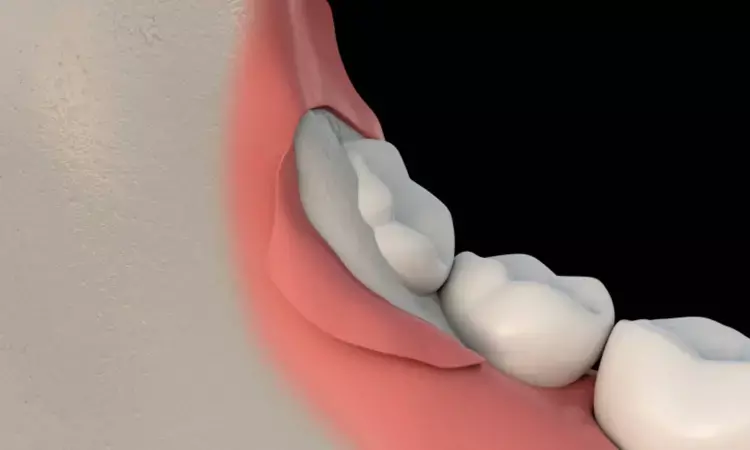- Home
- Medical news & Guidelines
- Anesthesiology
- Cardiology and CTVS
- Critical Care
- Dentistry
- Dermatology
- Diabetes and Endocrinology
- ENT
- Gastroenterology
- Medicine
- Nephrology
- Neurology
- Obstretics-Gynaecology
- Oncology
- Ophthalmology
- Orthopaedics
- Pediatrics-Neonatology
- Psychiatry
- Pulmonology
- Radiology
- Surgery
- Urology
- Laboratory Medicine
- Diet
- Nursing
- Paramedical
- Physiotherapy
- Health news
- Fact Check
- Bone Health Fact Check
- Brain Health Fact Check
- Cancer Related Fact Check
- Child Care Fact Check
- Dental and oral health fact check
- Diabetes and metabolic health fact check
- Diet and Nutrition Fact Check
- Eye and ENT Care Fact Check
- Fitness fact check
- Gut health fact check
- Heart health fact check
- Kidney health fact check
- Medical education fact check
- Men's health fact check
- Respiratory fact check
- Skin and hair care fact check
- Vaccine and Immunization fact check
- Women's health fact check
- AYUSH
- State News
- Andaman and Nicobar Islands
- Andhra Pradesh
- Arunachal Pradesh
- Assam
- Bihar
- Chandigarh
- Chattisgarh
- Dadra and Nagar Haveli
- Daman and Diu
- Delhi
- Goa
- Gujarat
- Haryana
- Himachal Pradesh
- Jammu & Kashmir
- Jharkhand
- Karnataka
- Kerala
- Ladakh
- Lakshadweep
- Madhya Pradesh
- Maharashtra
- Manipur
- Meghalaya
- Mizoram
- Nagaland
- Odisha
- Puducherry
- Punjab
- Rajasthan
- Sikkim
- Tamil Nadu
- Telangana
- Tripura
- Uttar Pradesh
- Uttrakhand
- West Bengal
- Medical Education
- Industry
Low-Level Laser Therapy Shows No Significant Relief After Wisdom Tooth Removal: Study Finds

Switzerland: A new research, published in the Journal of Oral and Maxillofacial Surgery revealed that low-level laser therapy (LLLT), often promoted as a modern, non-invasive solution to reduce postoperative discomfort, may not offer the expected relief after wisdom tooth extraction.
Postoperative pain, swelling, and trismus are the most frequently encountered complications following the surgical removal of wisdom teeth. While various methods have been explored to manage these symptoms, the effectiveness of low-level laser therapy remains a topic of debate.
In this context, the present study aimed to assess whether LLLT could offer a significant reduction in pain, swelling, and trismus after the extraction of both upper and lower third molars. Esra Sekerci, Assistant Dentist in Further Training for Oral Surgery, Clinic of Cranio-Maxillofacial and Oral Surgery, Center of Dental Medicine, University of Zurich, Switzerland, and colleagues hypothesized that LLLT would result in greater postoperative relief compared to the side of the mouth treated with a placebo laser (PL), thereby providing a potential adjunctive tool for improving patient comfort and recovery.
For this purpose, the researchers conducted a double-blind, randomized, split-mouth study at the University of Zurich involving 20 healthy patients aged 18 to 24 with impacted wisdom teeth. Patients were randomly assigned to receive either low-level laser therapy (LLL) or placebo laser (PL) treatment. Pain, swelling, and trismus were assessed preoperatively and on days 3 and 7 after surgery using a visual analog scale, 3D scanner, and ruler, respectively. Age and sex were comparable across groups and included as covariates. Statistical analysis was performed using a two-sided Wilcoxon signed-rank test with a significance level of 0.05.
The key findings of the study were as follows:
- The study included 20 subjects with a mean age of 20.4 years (±1.9), of whom 55% were female.
- On day 3 post-surgery, the median pain score was 2.5 in the LLLT group and 2.0 in the placebo group.
- Median swelling on day 3 was 10,697 mm³ in the LLLT group compared to 13,407 mm³ in the placebo group.
- By day 7, median swelling was 2,379 mm³ in the LLLT group and 1,553 mm³ in the placebo group.
- Median mouth opening (trismus) on day 3 was 35 mm in the LLLT group and 35.5 mm in the placebo group.
- On day 7, the trismus measured 43.5 mm in the LLLT group and 48 mm in the placebo group.
The authors concluded that postoperative low-level laser therapy showed no statistically significant effect in reducing pain, swelling, or trismus following wisdom teeth removal. They acknowledged that a key limitation was the inability to assess the specific effect of the 670 nm wavelength, and noted that the laser was applied only once post-surgery.
“Future studies should explore varied LLLT protocols, including multiple irradiations, different wavelengths, and anatomical targets,” the authors wrote. They emphasized the importance of maintaining rigorous, bias-minimized study designs—such as their randomized, split-mouth, double-blind approach—and concluded that further research is needed to refine and optimize the clinical use of LLLT in oral surgery.
Reference:
Sekerci E, Schiefersteiner M, Wiedemeier D, Valdec S. Is Low-Level Laser Treatment Effective in Reducing Pain, Swelling, and Trismus After Removing Impacted Maxillary and Mandibular Third Molars? J Oral Maxillofac Surg. 2025 Apr 1:S0278-2391(25)00189-2. doi: 10.1016/j.joms.2025.03.017. Epub ahead of print. PMID: 40252691.
Dr Kamal Kant Kohli-MBBS, DTCD- a chest specialist with more than 30 years of practice and a flair for writing clinical articles, Dr Kamal Kant Kohli joined Medical Dialogues as a Chief Editor of Medical News. Besides writing articles, as an editor, he proofreads and verifies all the medical content published on Medical Dialogues including those coming from journals, studies,medical conferences,guidelines etc. Email: drkohli@medicaldialogues.in. Contact no. 011-43720751


